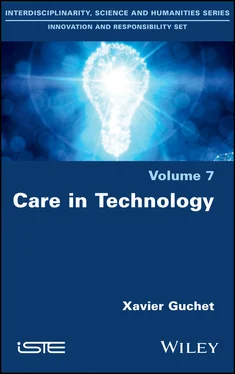275 251
276 252
277 253
278 254
279 255
280 256
281 257
282 258
283 259
284 260
285 261
286 262
287 263
288 264
289 265
290 266
291 267
292 268
293 269
294 270
295 271
296 272
297 273
298 274
299 275
300 276
301 277
302 278
303 279
304 280
305 281
306 282
307 283
308 284
309 285
310 287
311 288
312 289
313 290
314 291
315 292
316 293
317 294
318 295
319 296
320 297
321 298
322 299
323 300
324 301
325 302
326 303
327 304
328 305
329 306
330 307
331 308
332 309
333 311
334 312
335 313
336 315
337 316
338 317
339 318
To Bernadette Bensaude-Vincent, who taught me a lotIn testimony of friendship
Innovation and Responsibility Set
coordinated by
Robert Gianni and Bernard Reber
Volume 7
Xavier Guchet

First published 2021 in Great Britain and the United States by ISTE Ltd and John Wiley & Sons, Inc.
Apart from any fair dealing for the purposes of research or private study, or criticism or review, as permitted under the Copyright, Designs and Patents Act 1988, this publication may only be reproduced, stored or transmitted, in any form or by any means, with the prior permission in writing of the publishers, or in the case of reprographic reproduction in accordance with the terms and licenses issued by the CLA. Enquiries concerning reproduction outside these terms should be sent to the publishers at the undermentioned address:
ISTE Ltd
27-37 St George’s Road
London SW19 4EU
UK
www.iste.co.uk
John Wiley & Sons, Inc.
111 River Street
Hoboken, NJ 07030
USA
www.wiley.com
© ISTE Ltd 2021
The rights of Xavier Guchet to be identified as the author of this work have been asserted by him in accordance with the Copyright, Designs and Patents Act 1988.
Library of Congress Control Number: 2020951011
British Library Cataloguing-in-Publication Data
A CIP record for this book is available from the British Library
ISBN 978-1-78630-559-6
Several colleagues were kind enough to re-read all or part of this book and give me suggestions for improving it. I thank them very warmly: Bernard Reber first of all, for his very careful reading and his advice, as well as Emanuele Clarizio whose comments are always invaluable. Charles Lenay and Pierre Steiner then, who enlightened me on the TAC thesis and its philosophical sources. Dimitri El Murr who allowed me to see more clearly in certain terminological problems linked to ancient Greek.
My thanks also go to Rionne, for his support and encouragement.
A good number of the works that combine innovation and responsibility 1, science and society, or even ethics and new, emerging or controversial technologies do not really take the technologies themselves seriously, nor their relationships to humans and the environment. To be more precise and less unfair, they still base themselves upon dualisms: nature/technology, technology/life, technology/humans, humans/nature, subject/object. What they are desperately lacking is an informed, balanced, and plausible philosophy of technology. However, this well-documented work by Xavier Guchet, who leads an interdisciplinary team at the University of Technology of Compiègne, member of the Sorbonne University Alliance, offers not only a strong thesis, but is backed up by a panorama as broad as it is assembled to good use. I emphasize the fact that his immersion in a university of engineers gives even more credit and plausibility to his work. This book is not only addressed to philosophers, but to engineers and any person who takes account of our technological environments 2, sometimes as threats, sometimes as sources of revelation and solutions, but also with a role to play in our definition as humans.
First of all, we have here a state of the art of the most interesting approaches to the philosophy of technology, ranging from Greek philosophy, especially that of Aristotle, to contemporary work. Configurations of the debate which we have inherited from ancient times have not lost their relevance. Against the Sophists who enthusiastically welcomed the development of technology considered from the perspective of an infinite progress, Plato’s metaphysics already indicated this danger of unlimited variation of forms in the polis , by separating Being and becoming, and submitting the latter to the unchangeable order of the former. Even more, Aristotle had already domesticated technology in a quadruple principle of limitation that prevents a collapse into excess: by form (formal cause), by the “implicit forms” of the material (material cause), by the ultimate purpose (final cause) and by the corporeal possibilities of the living being (efficient cause).
Xavier Guchet therefore presents the broad progress of the biological philosophy of technology, whose connecting thread is the concept of the externalization of life in technology, with great names as Ernst Kapp, Alfred Espinas, Henri Bergson, Edouard Le Roy, André Leroi-Gourhan, Georges Canguilhem, and some lesser known such as William Morris, John Dewey, Lewis Mumford, Laszlo Moholy-Nagy, Gilbert Simondon, whose common feature is that they have considered technology from the point of view of its links with life, with the theme of projection of the organs or of externalization. This also concerns René Descartes, Karl Marx, Arnold Gehlen, Helmuth Plessner, Jose Ortega y Gasset, Paul Alsberg, Francisco Varela, Pietro Montani and Bernard Stiegler. It is gratifying that the Innovation and Responsibility set of books devotes several pages to the French philosopher of technology Gilbert Simondon, quite unique in this field and little known in the English language, at least in a form which is not solely exegetic.
One of the originalities of this discussion is the presentation of the Kantian conception of technology as a decisive philosophical reading of the divorce between technology and life, as it was emerging in the 18th century. Kant’s genius is to have endorsed this divorce, while indicating, as if in negative space, the conditions for it to be surpassed. Far from continuing to conceive technology, as had been done before him, as organon , he proceeded to a split in the very concept of technology in parallel with another, that between organic life and the life of any singular rational and moral person. Technology points toward the representation of goals, but it also sinks into the depths of the body to the point of lodging in the automatism of the living machine. It is somewhat mechanical and somewhat finalized, between causation and purpose. We can understand this “somewhat” as “at the same time”.
Companionship with Kant allows Xavier Guchet to discuss the work of Dewey on the aesthetic experience as a perception of the relationship between my action and its effects in the world, between the things I manufacture and the relations that these things will forge with other beings in the world, or recent research in bio-aesthetics. This is the case for example with Montani who sketches a third way, that of the concept of institution, between the heteronomous constitution of the subject and the forms of its experience through technology and the absolute self-constitution of the subject. The concept of institution allows us to say that the subject is not self-created and what brings it into existence is not a set of structures imposed upon it by a foreign authority. The subject does not belong to itself without experiencing a sort of heteronomy.
Читать дальше












